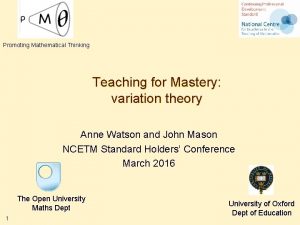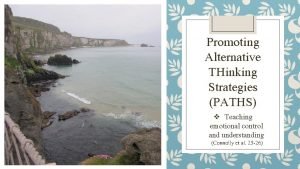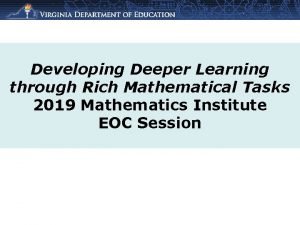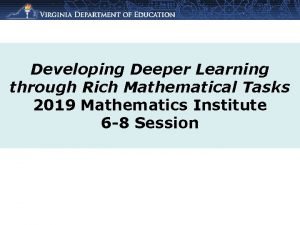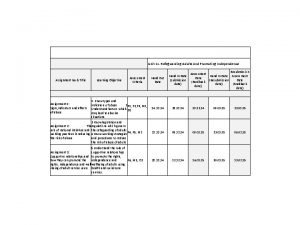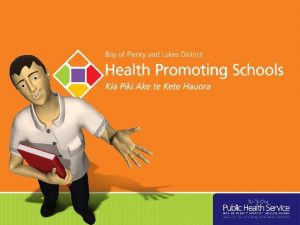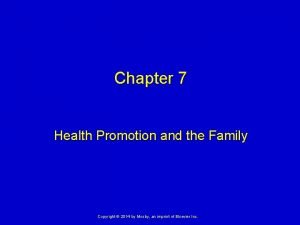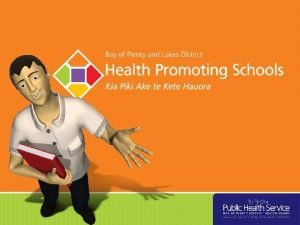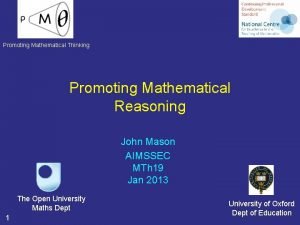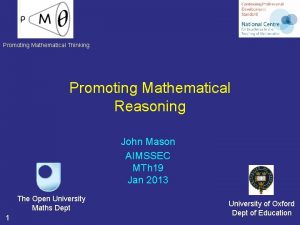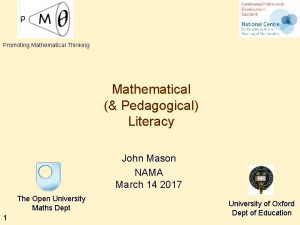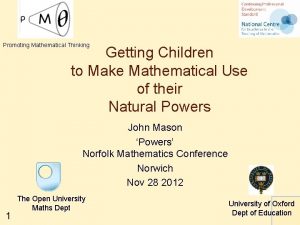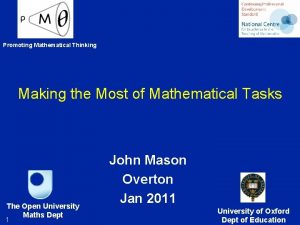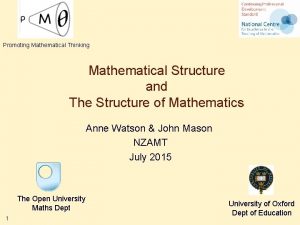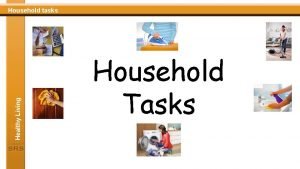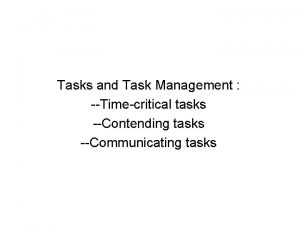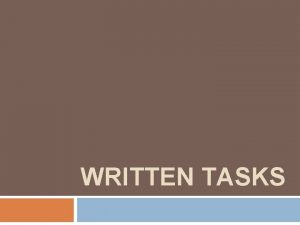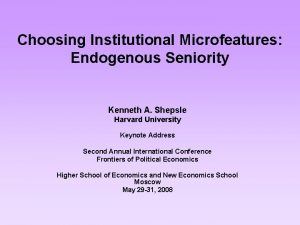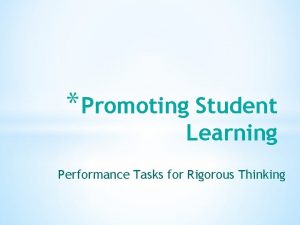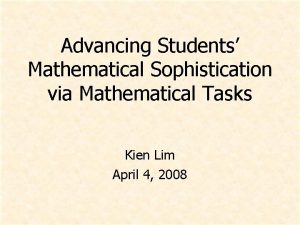Promoting Mathematical Thinking The MicroFeatures of Mathematical Tasks















- Slides: 15

Promoting Mathematical Thinking The Micro-Features of Mathematical Tasks Anne Watson & John Mason Nottingham Feb 9 2012 The Open University Maths Dept 1 University of Oxford Dept of Education

Our design methods /Task audience – teachers & novice teachers; teacher educators /Task purposes – to bring to awareness important mathematical and pedagogical constructs – to offer task-types rather than particular tasks – to promote deep consideration of concepts – to provide current experience of ways of working mathematically – to articulate effective mathematical actions /What? : /NOT roll out materials but methods of working [and possible tasks] 2

Generic Task structures /Unusual features (e. g. inter-rootal distance) … /Another & another Generic strategies for teachers to /Imagine a … add to their repertoire (Q&P; Thinkers) /Silent lesson /Make up one which. . . . /Change. . so that. . . 3

Generic Task Stuctures /Microtasks are generic strategies applied in particular conceptual fields, e. g. • teacher asks students to compare. . • teacher asks students to invent a representation of … /(generic tactics which become didactic in a conceptual context) Sequences of microtasks which direct development of a network of conceptual ideas Cf. (Hypothetical) learning Trajectories Cf. Spiral Curriculum 4

Recent example of task construction and sequencing /Audience: primary mathematics teacher educators’ residential workshop /Purpose: – to bring to awareness important mathematical and pedagogical constructs – to promote deep consideration of concepts – to provide current experience of ways of working mathematically /Choices: to bring to the surface or to dig deep to find. . . 5

Count down /Count down from 10 to -10 /How many numbers /Why? What next? Number or linearity? 6

Number /Count down from 101 in steps of 1 1/10 /Count down from 46 in steps of 1 1/5 Make up some like this Predictable issues? 7

Linearity /Plot countdowns as graphs /Predictable issues 8

Design issues relevant to this sequence /Who? /What purpose? /Context, resources, time /My understanding of underlying conceptual issues /Organised direct (and directed) experience of these /Dig deep rather than bring to the surface! /Sequencing tasks to address the same issues again and again /Importance of associated ‘pedagogical’ context and strategies 9

Genesis of ideas: the story of elastics /Ulla Runesson using elastic to vary the ‘whole’ in fractions; dimension of variation /Problem with seeing multiplication only as repeated addition or arrays (Nuffield study) /Need a model for scaling (BEAM elastic; PGCE Cabri) /John works repeatedly with a range of audiences exploring dimensions of variation, making kit, and observing their actions and comments /Microtask sequence: expansion; contraction; expansion and related contraction e. g. 3/2 and 2/3; invariance & (MGA) 10

Embedded Q&P /Compare /Same/different /Representations /Exemplification /Variation /Construct 11 meeting constraints

Principles /Need for raw material for empirical conjecture and-or structural relationships (from experience, observation, pattern) conjecture /Strong relation between inferrable relations and underlying conceptual structure /Attention directed to structural relationships as properties 12

Reflecting on Designing Bigger Tasks /Macro worlds for classroom exploration need appropriate pedagogy /Need for a strong relation between likely actions, inferrable (? ) relations, and underlying conceptual structure (Witch Hat) /Realisable mathematical potential (Christmas decorations) /Maths has to be worthwhile and necessary /Reasoning about relationships; not empirical fiddling /Purpose and utility (Ainley and Pratt) /Vertical mathematisation (FI) 13

Our ideals /Pick up others’ task and push-probe mathematical potential ourselves: Dudeney goat-tethering /Influence/develop student mathematical reasoning and/or conceptual understanding /Maths has to be necessary to some further end, yet all can get started /Vary the initial level of complexity and generality so as not to create dependency /Non-Tasks: chord-slope /If … is varied, what will attention be drawn to? /Are the mathematical affordances ‘worth the calories’? 14

Follow-Up /Questions & Prompts (Primary & secondary versions) /Thinkers /Mathematucs as a Constructive Activity /Thinking Mathematically /Design & Use of Mathematical Tasks /Teaching Mathematics: Action and Awareness /Contact: j. h. mason @ open. ac. uk 15
 Mastering microfeatures
Mastering microfeatures Promoting alternative thinking strategies
Promoting alternative thinking strategies Vdoe math rich tasks
Vdoe math rich tasks Vdoe rich mathematical tasks
Vdoe rich mathematical tasks Elements of mathematical economics
Elements of mathematical economics Thinking about you thinking about me
Thinking about you thinking about me Thinking about your own thinking
Thinking about your own thinking Analytic vs holistic thinking example
Analytic vs holistic thinking example Perbedaan critical thinking dan creative thinking
Perbedaan critical thinking dan creative thinking Positive thinking vs negative thinking examples
Positive thinking vs negative thinking examples Philip curry business
Philip curry business Unit 11 safeguarding adults and promoting independence
Unit 11 safeguarding adults and promoting independence Health promoting school
Health promoting school Chapter 7 promoting health and wellness
Chapter 7 promoting health and wellness Do. 27 s. 2015 promoting family earthquake preparedness
Do. 27 s. 2015 promoting family earthquake preparedness Health promoting schools model
Health promoting schools model
